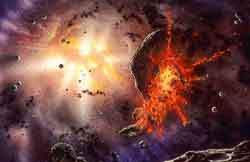THE NATURAL ENVIRONMENT
Geography 101
ToC
SKY
Origin
Air
Layers
Sunlight
Scatter
Refract
Hawai'i
Origin
 The
Earth is thought to have formed by the accretion, or a gradual accumulation
of material that formed the early solar system -- so-called
planetesimals,
gas, and dust -- brought together by mutual gravity.
The most violent phase of accretion ended about four and a half billion
years ago, though
the
process
continues today as shown by the many recent meteor craters identified on Earth's
surface.
The
Earth is thought to have formed by the accretion, or a gradual accumulation
of material that formed the early solar system -- so-called
planetesimals,
gas, and dust -- brought together by mutual gravity.
The most violent phase of accretion ended about four and a half billion
years ago, though
the
process
continues today as shown by the many recent meteor craters identified on Earth's
surface.
Initially, Earth was probably too hot to retain atmospheric gases, suggesting that our modern air layer has developed entirely since that time. The gases forming the atmosphere, except Oxygen, have accumulated through outgassing from volcanoes, fumaroles, hot springs, and other venting sources from the inner Earth. These gases are primarily Nitrogen, Carbon Dioxide (CO2), and Water Vapor, along with a few others such as Methane, Carbon Monoxide, and Sulfur Dioxide. We know the gas composition because scientists studying volcanoes on the Big Island and other places regularly collect and analyze gas samples venting from Earth's interior.
|
|
BOX 1 |
Nitrogen does not react with other elements easily and has continued to increase, making up 78% of the air today. Carbon Dioxide reacts in the presence of water and is also absorbed in photosynthesis. Both of these processes have removed vast amounts of the gas from the atmosphere and stored it in limestone, fossil fuels, and other deposits reducing CO2 to a minor, but important, atmospheric constituent.
Water vapor has continued to seep into the atmosphere from the inner Earth. The amount of water vapor the atmosphere can hold, however, is limited and excess water falls to the surface as precipitation, such as rain and snow. This surface water has accumulated to form the oceans, lakes, ice caps, and other reservoirs of surface water that we take for granted today. Since Earth is still venting water vapor, a relevant question is, "Why aren't the oceans growing larger?" Scientists believe that the amount of water added to the surface by venting matches the amount sucked back into Earth's interior by plate tectonics, making the surface water volume fairly stable. While outgassing appears to be the source of Earth's surface water, some debate exisits over where the original interior water came from. Some argue for extraterresrial origins, like asteroid and comet impacts, while others favor chemical processes.
Composition of
Dry Air |
||
|
Nitrogen |
78%
|
|
Oxygen has been a relatively recent addition to our atmosphere, building up over the past 2 billion years. Oxygen is a waste product of photosynthesis, the process by which plants derive energy, and thus the gas has a biologic origin. The earliest Oxygen producing organisms lived in the oceans where they were protected from toxic exposure to strong ultraviolet (UV) radiation. As the gas increased in the atmosphere, it gradually formed a UV-blocking ozone (O3) layer in the stratosphere, allowing life to colonize the exposed land surfaces.
The buildup of Oxygen was accompanied by a reduction in Carbon Dioxide, which continues to be a major component of other planetary atmospheres such as those of Venus and Mars.